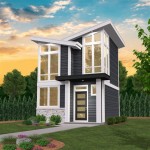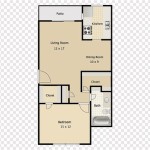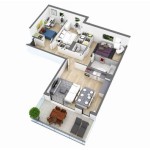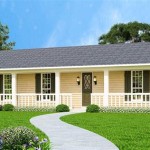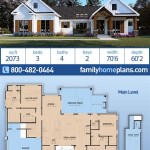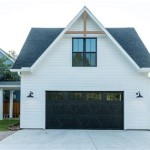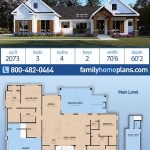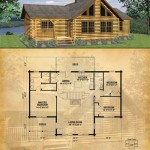Floor Plans With Safe Room: Designing for Security and Peace of Mind
The concept of incorporating a safe room, also known as a panic room or security room, into residential floor plans has gained significant traction in recent years. This trend reflects an increasing awareness of potential threats, ranging from severe weather events like tornadoes and hurricanes to home invasions and other security concerns. Integrating a safe room into the design of a home requires careful consideration of various factors, including location, size, construction materials, and functionality. The goal is to create a secure space that can provide occupants with temporary protection during emergencies.
A well-designed safe room is more than just a reinforced closet. It's a strategically planned component that integrates seamlessly with the overall architecture of the house while offering maximum protection. The design process involves collaboration between architects, engineers, and security specialists to ensure the safe room meets specific safety standards and performance expectations. This article will explore the key considerations in designing floor plans that incorporate a safe room, focusing on the elements that contribute to its effectiveness and overall integration within the home.
Location and Accessibility
The location of a safe room within the floor plan is paramount to its effectiveness. Ideally, the safe room should be easily accessible from multiple points within the house, particularly bedrooms and living areas. A central location minimizes the distance occupants need to travel to reach safety, especially during a rapidly unfolding emergency. Locations near bedrooms are especially important to consider, as this is often where people are when asleep.
Consideration should also be given to the potential pathways to the safe room. It's important to ensure these pathways are relatively free of obstacles and are easily navigable, even in low-light conditions. Avoid placing the safe room in areas that are prone to flooding or are otherwise vulnerable to external threats. Interior rooms, particularly those without windows or exterior walls, are often preferred locations due to their inherent protection from wind and forced entry. Basements can offer a degree of natural protection from tornadoes, but are more susceptible to flooding. Conversely, attics are less accessible and potentially vulnerable to fire. Strategically placed closets, bathrooms or under-stair compartments can be converted, or incorporated into new construction, into safe rooms.
The accessibility of the safe room shoudl also consider the needs of all potential occupants. If the home includes elderly or disabled individuals, the design must accommodate their mobility limitations. Ramps or elevators might be necessary to provide access to a safe room located on a different floor level. Doorways should be wide enough to accommodate wheelchairs or other mobility devices. It's also important to ensure that the interior of the safe room is designed to be comfortable and functional for individuals with diverse needs.
Construction and Materials
The construction of a safe room involves using materials that can withstand extreme forces, such as those generated by high winds, projectiles, or forced entry. Reinforced concrete is a common choice for the walls, floor, and ceiling of the safe room. Concrete offers excellent resistance to both impact and penetration. Steel reinforcement, in the form of rebar, is typically added to the concrete to further enhance its structural integrity. The thickness of the concrete and the spacing of the rebar are determined by the specific threat level the safe room is designed to withstand. Different testing standards are employed to show the material’s resistence. These standards, like those from organizations such as FEMA, ensure materials can withstand specific conditions, for instance a specific wind speed or impacts from certain projectiles.
The door to the safe room is a critical component and must be as strong as the walls. Steel doors with heavy-duty frames and multiple locking points are typically used. The door should be designed to resist forced entry attempts, such as kicking, prying, or drilling. Ballistic-rated doors can offer higher protection. The door frame should be securely anchored to the walls of the safe room to prevent it from being forced open. Hinges and locks should be tamper-proof and resistant to manipulation. A peephole or a video surveillance system can allow occupants to monitor the situation outside the safe room without opening the door.
Ventilation is another essential consideration. The safe room should have a means of providing fresh air to occupants, especially if they are expected to remain inside for an extended period. A dedicated ventilation system with an air filtration component can help remove contaminants from the air and maintain a comfortable environment. This system might include filters to remove smoke, dust, or other airborne particles. Emergency power backups should be installed so the ventilation system remains operational, along with any other essential systems, in the event of a power outage.
Functionality and Amenities
Beyond its structural integrity, the functionality of a safe room is crucial to its effectiveness. The safe room should be equipped with essential supplies and amenities to ensure the comfort and safety of occupants during an emergency. This includes a supply of drinking water, non-perishable food, first-aid supplies, and communication devices.
Communication is a key aspect of the safe room's functionality. A landline telephone or a two-way radio can allow occupants to communicate with emergency services or family members outside the safe room. A battery-powered radio can provide access to emergency broadcasts and weather updates. Cellular service may be unreliable during emergencies, so alternative communication methods are essential. Consider a satellite phone for reliable communication if cell service is questionable in your area.
Beyond the essentials, consider the specific needs of the occupants. If the safe room is intended for long-term occupancy, it may be necessary to include a portable toilet, bedding, and entertainment options. The design should also consider the psychological impact of being confined in a small space for an extended period. Including natural light, when possible, or simulating natural light with appropriate artificial lighting can help reduce feelings of claustrophobia. Comfortable seating and a calming color scheme can also contribute to creating a more comfortable and less stressful environment.
In addition to the above considerations, fire resistance is also an important factor. While safe rooms are often designed to withstand wind and impact, they should also be resistant to fire. Fire-resistant materials should be used in the construction of the safe room, and a fire extinguisher should be readily available inside. Smoke detectors and carbon monoxide detectors should be installed to provide early warning of a fire or carbon monoxide leak.
Ultimately, the design of a floor plan with a safe room is a complex process that requires careful planning and attention to detail. By considering factors such as location, construction materials, functionality, and amenities, it is possible to create a secure space that provides occupants with peace of mind and protection during emergencies. Engaging with experienced architects, engineers, and security specialists is crucial to ensure the safe room meets specific safety standards and performance expectations. A floor plan with a safe room is an investment in safety and security, offering a valuable safeguard for homes and families.

Plan 59527nd Lovely 4 Bed Home Design With Safe Room

One Level Hill Country House Plan With Safe Room 48600fm Architectural Designs Plans

Exclusive One Level House Plan With Safe Room 510182wdy Architectural Designs Plans

Elegant One Story House Has Safe Room Plan 4906

3 Bed 3870 Sq Ft Farmhouse Plan With Safe Room Wraparound Porch

1 Story Barndominium House Plan With Safe Room 2758 Sq Ft 623116dj Architectural Designs Plans

Acadian House Plan With Safe Room 83876jw Architectural Designs Plans

Pin Page

Ultimateplans Com House Plan Home Floor Number 101159

3 Bed 3870 Sq Ft Farmhouse Plan With Safe Room Wraparound Porch

